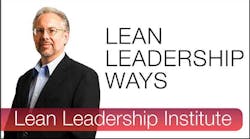For manufacturing that is equipment-intensive, how the equipment works is often the main factor in productivity. Total Productive Maintenance (TPM) has become a buzzword in lean and a generally accepted metric is Overall Equipment Effectiveness (OEE). This is measured as the product of three factors:
OEE = Availability x Performance x Quality
Availability = run time/total time
Performance = Total count of parts/target count (based on a standard)
Quality = Good count/Total count
One of our participants, Ignacio S. Gatell, on our LinkedIn site The Toyota Way site wrote a sacrilegious blog about “How OEE will NOT help you.” He questions whether companies using OEE really understand it, can explain it clearly to their customers, and understand what it means to compare OEE as a KPI across plants. He questions whether even plant managers understand how it is calculated and what it means.
He makes some excellent points, but one sticks out for those who use OEE to compare performance using it as a KPI. OEE performance is relative to a baseline for a given piece of equipment; therefore it is specific to that equipment and not comparable across departments or plants.
But there is a broader issue. Using OEE as an indicator, the product of three different things almost guarantees confusion and makes it difficult to use establish targets for improvement. While Gary Convis and I were writing The Toyota Way to Lean Leadership he became the CEO of Dana (truck chassis parts supplier). He quickly learned that the company was operating without KPIs that could be seen from his level to the work group level, so he worked with a team to develop and pilot KPIs by region. One that survived was OEE. I was surprised and asked Gary about it, mentioning I have never seen OEE measured in Toyota. He said it was an accepted measure within the Dana culture and he wanted to support what they have used and believe works.
Within one year I found he had eliminated OEE as a measure and replaced it with equipment uptime, or what some in Toyota call “operational availability.” What percentage of what should come out of the machine in a normal shift comes out of the machine? This is very easy to understand throughout the shop floor. It turned out that when Gary visited a plant he was hard pressed to find anyone who actually understood what OEE meant and was using it for improvement, and he himself did not understand it.
The only good argument I have heard for OEE is that at a macro-level in a plant it provides a high level picture of how your equipment is functioning. You can multiply it across, say, five linked machines in a series and get a picture of the percentage of time you can expect to get a good part out—which is often depressingly low. Then you can use it as a signal detector to know where to focus improvement activity. But this is at the plant level, usually led by engineering. For kaizen at the work group level and as a KPI for operations I believe it is confusing because it aggregates so much and is hard to act upon.
Recently I visited Toyota’s engine and transmission plants in Buffalo, West Virginia. In the transmission plant they explained that the way everybody—salaried and hourly—earns raises and bonuses each year is based on production of transmissions. That is what pays for the plant. The key factors in production are equipment running when it is supposed to be running and quality. Everybody understands “operational availability” (OA). They have a counter showing how many transmission parts each machine should be producing through the day based on the takt (customer demand rate) and what they are producing. They measure OA by shift. They also measure defects/100 in a separate quality measure, both externally shipped to the customer, and more important internal defects that are caught in inspection and are repaired or scrapped.
The way OA is used is not for comparing performance or any type of individual reward or punishment system. It is used for improvement. The overall performance board for the plant shows OA by shift. This then is tied to department boards and even drills down to hourly OA. Every hour OA is examined and comments are written about the reason for any downtime for a specific machine. Most of the problems are unique, one of a kind and lead to immediate countermeasures by maintenance. Recurring items go onto a tracking sheet and follow a more rigorous problem-solving process to get to the root cause.
At Toyota, standards for uptime, set in Japan, are very high—in the range of 98 to 99%. There is little inventory and often machines are set up sequentially so one machine going down quickly shuts down a whole line of machines. It is rare walking around in a Toyota plant to see any piece of equipment stopped for more then a few minutes. Their equipment works so well, not because of elaborate measurement systems, but because of rapid response to breakdowns and rigorous problem-solving when a recurring cause is detected. Continuous improvement is at the center of equipment wellness and continuous improvement can only be done by capable, motivated, thinking people.
_______________________________________
Liker Leadership Institute (LLI) offers an innovative way to learn the secrets of lean leadership through an online education model that is itself lean, and extends that lean education far beyond the course materials. Learn more about LLI's green belt and yellow belt courses in "The Toyota Way to Lean Leadership" and "Principles of Lean Thinking" at the IndustryWeek Store.
Join our online community for information about our webinars and access to our network.




